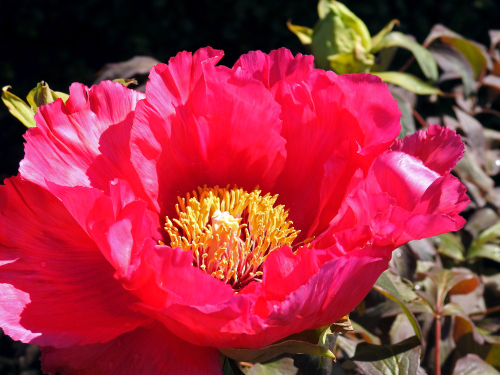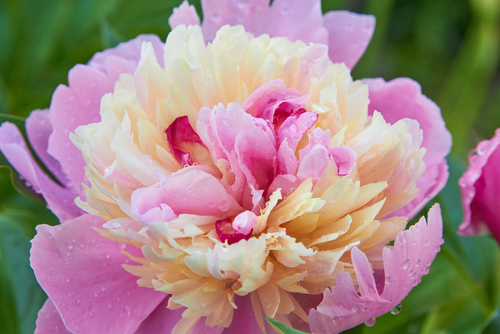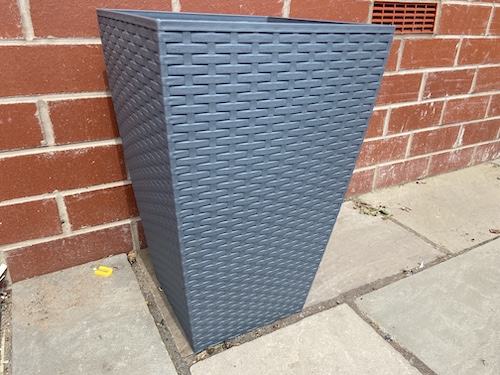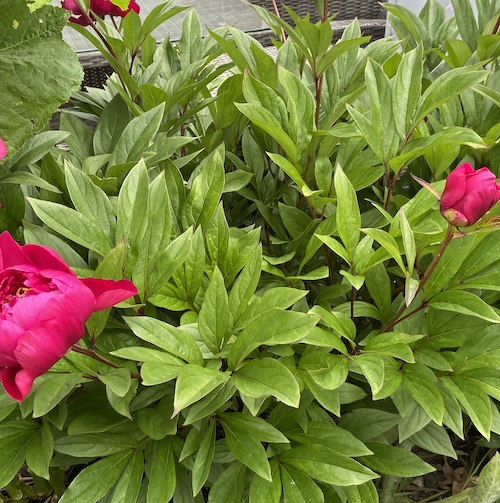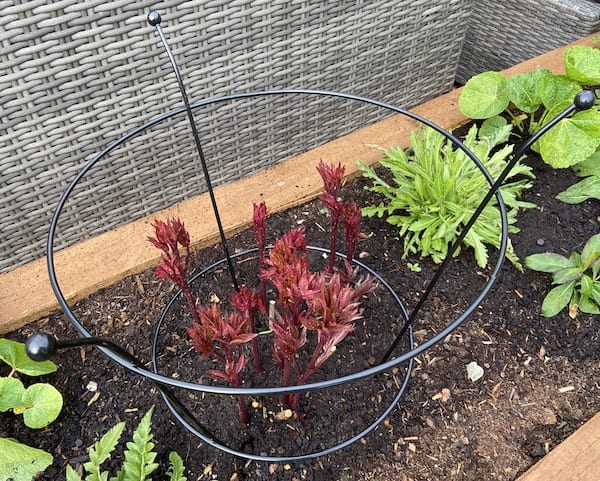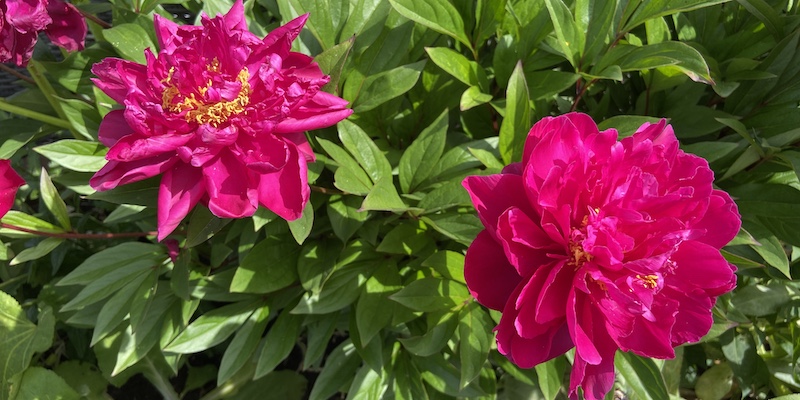
How to grow peonies in pots
Our site is reader supported, this means we may earn a small commission from Amazon and other affiliates when you buy through links on our site.
I nearly always recommend growing peonies in the ground or in large raised beds if you can. However, I have also successfully grown peonies in pots. After all, when I worked as a nurseryman, I grew hundreds of peonies in large deep containers to sell at garden centres. In some cases, you might only have the space to grow them in containers. With this in mind, in this guide, I’m going to give all the secrets and tips for growing peonies in pots successor and although it can be a challenge, it can certainly be done if you do the right things.
It starts with a suitable variety of peonies so this is what I will start with below.
Select the appropriate peony variety for container growing
Look for varieties of peonies marked ‘patio’ or ‘intersectional’ for growing in pots, this is important to have any chance of keeping them happy. These don’t grow as tall or as bushy as the regular varieties that are best suited to large borders. Here are some of my favourite varieties worth considering
Paeonia ‘Dublin’ (Patio Peony ‘Dublin’)
This produces a single white flower with a golden yellow centre.
Height: 50cm; width: 30cm.
Paeonia ‘Moscow’ (Patio Peony ‘Moscow’)
This has semi-double flowers in a bright red with yellow cemtres.
Height: 60cm; width 40cm.
Paeonia lactiflora ‘Gay Paree’ AGM (Peony ‘Gay Paree’)
This bush produces fragrant flowers in the mid-growing season. The blooms are single flowers with cerise pink outer petals. At the centre are pink petals with cream edges.
Height: 75cm; width 50cm.
Select the perfect pot size
As you can see from the suggested varieties above, even these smaller peony bushes grow quite tall to around 50cm and just as wide. And they have fairly deep root systems I always go for deep pots but just be careful not to go too large as it’s better to plant them into large pots in stages. You can always repot it after three to four years. But you do need a pot which contains its growth for a few years.
Start with a pot that’s about 30cm to 50cm wide. Also, make sure there are holes in the bottom of the pot (drill some if there are none) and the base is wide enough so that it won’t easily topple over as peonies can be very top heavy once in full flower.
Select the pot type and material
Peonies need lots of room to grow and spread out. Choose a fairly deep pot that’s quite heavy. The weight of the pot needs to offset the weight and height of the bush so everything doesn’t become top heavy and fall over which I have already briefly touched on. Consider wood, clay or plastic pots. If the pot material is on the light side, you need to place stone or broken crockery in the bottom of it to weigh it down.
Stones or crockery (old broken pots are perfect) in the bottom of the pot are a good idea anyway to cope with drainage. Peonies are drought tolerant and don’t like to sit in water. They need good drainage. So your container needs quite a few drainage holes in the bottom, even if you have to make additional ones yourself.
Position the pot
Move the pot to its permanent home. Peonies need at least six hours of full and direct sunshine every day to get the most out of them. They don’t like to be in shade which is one of the causes of them not flowering as well as being planted too deeply so don’t place the container near a wall or a fence or within the shadow of a tree or large bush.
Plant the peony shrub
The best time to plant peonies is in the fall (Autumn). This is especially true if you’re planning on dividing the peonies you already have and planting some of the divided sections in pots.
Peonies need soil that’s loamy and well-draining. Use organic compost as the soil and throw in some peat moss or coconut peat to lighten the soil mix and help with drainage. Another soil mixture you can use in John innes potting compost which is soil based and mix in some grit to help improve drainage. I like this mixture as it holds the moisture well in soil. Fill three-quarters of the pot with the soil, leaving room to add more over the roots.
Although peonies have deep roots, position the plant so that the crown of the root (where the shoots emerge from) only 2.5cm to 5cm below where the top of the soil will be. Make sure that the buds on the roots are facing upwards as that’s the direction they grow in. If you plant the root too deeply, you will probably have issues with your peony not flowering as this is one of the main causes.
Cover the root with more soil and tamp it down. Water the newly potted plant in well.
Peonies are generally pests and diseases free but there are some that can become a problem. Check out my guide on pests and diseases here for more on what to look for and how to treat them.
Providing support
Peonies, even the smaller varieties can get very large flower heads and tall foliage that often falls over when in full bloom. With this in mind, I always recommend using a plant ring, positioned in spring as the new shoots emerge to help support the stems and flowers as they grow. You can also use bamboo canes and string to help support the stems.
My 6 tips for successfully growing peonies in pots
- Any plant grown in a pot dries out quickly. Although peonies can handle being quite dry, check them regularly and water when necessary. This will usually be weekly or even daily in dry spells. Water them slowly and thoroughly and make sure that excess water drains out of the bottom of the pot.
- Fertilise peonies once a year. The best time to do this is either just before the blooming season or just after the blooms finish. A general feed will be fine.
- You don’t need to prune peonies at all. However, if you find they’re becoming too bushy and stopping the air circulation among the stems and branches, cut some of the branches out. Prune the bush in the autumn after all the blooms have faded away.
- Deadhead each bloom once it’s faded. This keeps the bush looking tidy and prevents pests and diseases from moving in to the dying flowers. Remember that deadheading won’t result in a second wave of flowers.
- Peonies in containers are sensitive to frost and freezing weather. Consider moving the pot into a greenhouse or a cool place in your home throughout the colder months. You can instead wrap the plant and pot in burlap or horticultural fleece. You can check my guide on peony winter care here.
- If something looks not quite right with your peony bush, check out my Peony pests and diseases to watch out for article.
- you might need to stake your peony bush to keep it upright. I give details for doing this in How to stake peonies and delphiniums to stop them falling over.
